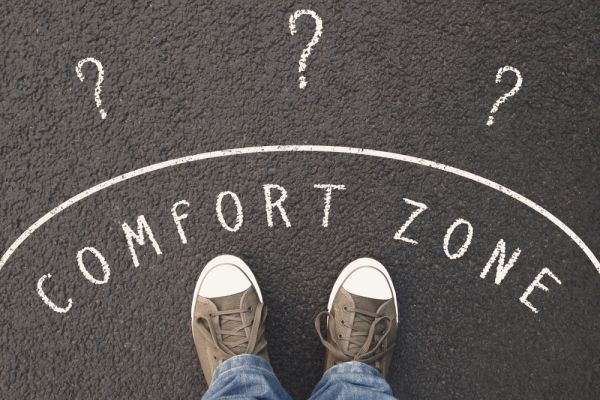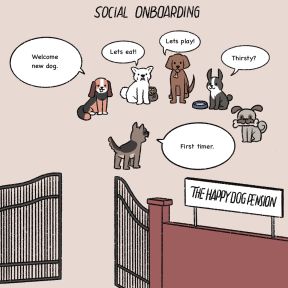Therapy for Anxiety
The function of psychotherapy for anxiety is not just to restore calm but to endow people with the ability to regain control over themselves whenever worry threatens to overtake them. The patient gains an enduring portable skill that can serve on the darkest night, the highest cliff, or in front of the largest audience. But there’s more. There is an irreducible, overarching value of therapy that can never be calculated into a fee—the presence of the therapist him or herself. Yes, the therapist delivers the promise of a treatment that will help, but there’s more. As social creatures, we have nervous systems exquisitely attuned to the influence of others. The presence of another person, especially one whose acknowledged mission is to help, constitutes a powerful signal of safety directly and deeply countermanding the (mistaken) alarms of threat that define the disorder of anxiety.
On This Page
- How do therapists treat anxiety?
- Why is therapy important for treating anxiety?
- Does therapy help in ways that medication does not?
- When is therapy used in conjunction with medication?
- What does therapy do?
- Does therapy help severe anxiety?
- What type of therapy is best for anxiety?
- When is it best to seek therapy for anxiety?
- Why is it important to seek treatment quickly?
- How effective is therapy?
- How long will it take to see any effect of therapy?
- How will I know that therapy is working?
- How long will therapy be needed?
- How long do the effects of therapy last?
- Can any type of therapy help?
- Is group therapy ever helpful?
- How is progress evaluated in therapy?
- Can therapy cure anxiety completely?
At the core of anxiety is a mistaken appraisal of danger in which threats are exaggerated, triggering an array of negative feelings that overwhelm patients and lead to avoidant behavior. Therapists take aim at the three big components of anxiety—worry, physical arousal or edginess, and avoidance—by teaching one or more well-researched programs of skills that are custom-tailored to patients’ own worst thoughts.
Patients learn what kinds of thoughts and behaviors pitch them into anxiety, how their own beliefs and statements about themselves contribute to their disorder, and how their own imagination magnifies dangers they perceive. They also learn how to reduce the physical distress of anxiety and how to approach the situations that trigger their symptoms or general discomfort. Therapy is usually conducted in a series of 12 or more sessions usually lasting about an hour. Often, patients are given “homework” assignments of exercises to engage in and skills to practice between sessions. For example, patients may be asked to pay attention and note how many times that have specific types of thoughts. The assignments are tools for helping patients become skilled at controlling their own thinking.
Therapy is important for treating anxiety because it transfers to patients the ability to allay their own distress any time it strikes. The skills that patients gain in therapy last far beyond the period of therapy, and endow patients with confidence that they do not have to be preoccupied with their own thoughts, they can cope with their feelings without being incapacitated by worry, they do not have to avoid situations or experiences that make them anxious, and they can develop more productive ways to manage their concerns and release the tension of anxiety. Those are skills typically acquired through the content of therapy.
Therapy also contributes to healing in ways no other treatment can. Because of the way the human nervous system is built, the presence of the therapist has a physiological effect that calms. Anxiety is a response to perceived danger. The presence of a friendly human being is possibly nature’s most powerful signal of safety; it activates a branch of the nervous system that slows down the heart rate and breathing, releases muscle tension, and mitigates alertness to danger.
Therapy for any condition almost always does something that medication cannot do—it helps patients learn about themselves. Randomized controlled clinical trials give cognitive and behavioral therapies an edge in effectiveness over medication in reducing the symptoms of anxiety. As a result, therapy is considered the first-line treatment. But what is perhaps more important, unlike with medication, where the therapeutic effects stop when treatment ends, the effectiveness of therapy endures for months and years beyond the period of treatment. That’s because therapy provides skills patients can use to calm their mistaken or exaggerated perception of danger and their physical and mental reactions to it.
Therapy also typically involves an alliance or bond with the therapist that helps motivate patients to comply with therapy. In addition, the person of the therapist is an active component of relief from distress in anxiety. The physical presence of the therapist has a physiological effect on the patient; It activates the parasympathetic nerve, which conveys a sense of safety and calms the body.
Therapy is used in conjunction with medication when patients are too anxious to even focus on therapy. The sense of pervasive danger that is a hallmark of the disorder compels their attention and their cognitive resources. Anxiety makes people impatient, too, which makes it hard for them to stay the course of therapy to see the benefits of treatment. Once the intensity of anxiety is calmed, patients may be able to tolerate therapy. In addition, the physical symptoms of anxiety can be all-consuming and highly distressing, and patients often want immediate relief from the somatic symptoms as an opening strategy. But medication does not make therapy more effective, nor does psychotherapy make medication more effective.
The goal of therapy, like the goal of all treatment, is to reduce suffering. In the case of anxiety, the source of suffering is an imagined negative outcome that lies just ahead. Cognitive and behavioral treatments of anxiety aim first and foremost to give you a good understanding of your own mind—how it works and how it can seduce you into believing that danger is just around the corner when it is not. It usually provides a guided tour of the kinds of thinking that amplify the sense of threat—and skills to change your thoughts and the negative feelings they engender. There is an array of cognitive distortions that people typically make, and patients learn how to identify and correct them. In examining the contents of thoughts and identifying what triggers them, cognitive and behavioral treatments or anxiety are squarely focused on people’s present experience, not on their past.
Therapy can help all degrees of anxiety, although in cases of severe anxiety, medication can be useful in calming the distressing physical and mental symptoms enough to allow patients to be receptive to therapy. It is the nature of anxiety to manifest in bodily symptoms such as pounding, rapid heartbeat; shallow, rapid breathing; general jumpiness and unease—sometimes to the point where patients feel they are having a heart attack or are about to die. Awareness of such symptoms—people differ in the degree to which they are aware of such sensations—typically compounds the sense of threat that triggers anxiety in the first place. For that reason, many patients are given benzodiazepine tranquilizers or other medication to provide acute relief. Studies show that cognitive behavioral therapy is most helpful for those with generalized anxiety disorder.
A large dossier of studies shows that the most effective and durable approach to anxiety involves some form of cognitive behavioral therapy (CBT). The two most widely used CBT methods to treat anxiety disorder are exposure therapy and cognitive therapy, often combined in various way. These therapies are delivered in a highly structured and systematic way while being attuned to the specific worries of each patient. They don’t just impart information and skills but provide ample opportunity for patients to practice the skills acquired, supporting the development of healthy new habits.
Exposure therapy has been a first-line behavioral treatment for anxiety disorders, especially phobias. It is highly effective for those whose wariness of specific objects and experiences—dogs, taking an airplane flight, or, after a traumatic experience such as an auto accident, being in a car—circumscribes their life. Avoidance is a self-defeating strategy. It only magnifies the sense of threat and the feeling of dread, which may expand to other situations and further compromise life.
Exposure therapy involves facing your fears, quite literally—but gradually and in the context of safety. Under controlled clinical conditions, patients gradually approach the troublesome stimulus they previously avoided. For those with panic attacks the physical sensations they fear are induced, and patients are given the chance to learn new responses to them. It has proven a highly effective way to durably extinguish the perception of threat. The treatment allows patients to develop the ability to regulate negative emotional responses, an activity centered in the bran’s prefrontal cortex.
Exposure therapy can be done in a variety of ways. The exposure can take place in real life, as when the patient is asked to give a speech before a small group of people. The exposure can occur by way of virtual reality, using digital technology to simulate every aspect of the experience of flying in a plane, for example. Or the experience can be imagined and recounted to a therapist. Exposure to what is feared is also a component of CBT.
For some people, countenancing even controlled exposure in a safe environment is overwhelming; they drop out of exposure therapy or avoid it entirely. Research is exploring a modified version of treatment—very brief exposure therapy, which involves exposing people to a feared object in doses so small the exposure fails to register on conscious awareness. Nevertheless, studies show, the technique can be effective in subduing the fear response.
Cognitive behavioral therapy (CBT) is a form of short-term psychotherapy based on the observation that the way people think affects the feelings they have and the behaviors they engage in. Like all good psychotherapy, it actually changes the brain—it rewires the brain, altering patterns of connection in the neural networks involved in thoughts and behavior.
Over the course of a dozen or more sessions, CBT helps patients cope with the three basic facets of anxiety—the cognitive processes that lead to endless worry; the disquieting physical symptoms such as racing heart and general jumpiness that are the sign of an aroused nervous system; and the behavioral consequences of anxiety, such as avoidance of what is feared, which otherwise winds up curtailing the patient’s life and robbing it of pleasure.
CBT teaches skills to diminish body-wide hyper-arousal; among the most effective are diaphragmatic breathing and relaxation techniques. The “cognitive” in CBT refers to the attention therapy pays to imparting the skills of detecting and correcting distorted thoughts, such as the expectation of disastrous outcomes to future events, on the grounds that maladaptive thoughts underlie maladaptive feelings and behavior.
Patients are taught, for example, to examine the evidence for and to challenge their automatic thoughts, rather than to accept them at face value. They learn to identify all-or-nothing thinking (“If I don’t get invited to the party, I will never have friends”), jumping to conclusions, catastrophizing from tiny bits of evidence, ignoring or discounting positive evidence, and other thought distortions. What the cognitive distortions all have in common is they create an avalanche of distressing feelings that overwhelm the ability to see the world realistically and cope with reality.
A variant of cognitive therapy known as Acceptance and Commitment Therapy recognizes the worrisome negative thoughts that anxiety furnishes but takes a different approach to them. Instead of refuting the cognitive distortions that hold sway in anxiety, ACT aims to release anxiety by not fighting the thoughts. It encourages patients to notice when their minds are coming up with stories rather than delivering the truth—and that recognition provides critical distance for more flexible thinking. It loosens the grip of an anxiety-provoking thought enough for problem-solving, for taking action that could influence the outcome in a positive way. Patients learn they can choose how their experiences turn out, rather than being paralyzed by anxiety.
As with all mental health conditions, early treatment prevents much unnecessary suffering and distress, has a better chance of inducing remission than treatment begun later in the course of disorder, and may prevent the development of inflammatory changes to the brain itself. In the absence of treatment, studies show, anxiety disorders tend to be chronic in both men and women, although symptoms may wax and wane over time. As anxiety disorders become chronic, they exact an increasing price on quality of life; people tend to avoid situations that arouse anxiety and restrict the activities they engage in. As their world shrinks, opportunities for pleasure narrow—one reason why depression so often accompanies anxiety. In extreme cases, anxiety can render people unwilling to leave their home. Untreated anxiety raises the risk of substance use, health problems, and suicidal behavior. Some people resist starting therapy because they have mistaken beliefs about the process itself.
Therapy should be started as soon as a diagnosis of anxiety is rendered. The longer anxiety goes untreated, the more difficult it becomes to treat. Early treatment is essential because disorders such as anxiety can change the brain, altering the reactivity of various brain structures, promoting readiness to detect and respond to potential threats, and changing the neural circuits such threat and alarms utilize. Research shows that anxiety is also linked to inflammatory changes in the brain, and panic disorder can exacerbate inflammatory activation. In fact the high levels of inflammatory changes are believed to be the link between anxiety disorders and an increased risk of cardiovascular disease.
There is evidence that the inflammation involved in anxiety can, over time, contribute to neurodegeneration and, in a vicious cycle, accelerate pathologic changes in the brain that make future recovery more elusive. Therapy helps patients develop the skills not just to beat back a current bout of anxiety but to prevent future ones as well. Early treatment has the highest likelihood of bringing about full remission of symptoms.
Studies show that both exposure therapy and CBT not only relieve symptoms but improve quality of life. Most effective for many anxiety disorders is a treatment protocol that has elements of both exposure therapy and cognitive therapy. The evidence supports therapy as a first-line treatment across the lifespan and for all types of anxiety disorder. And while therapy is at least as effective as medication for the duration of treatment, its effects far outlast those of medication. In addition, it is better tolerated: Fewer patients drop out of psychotherapy for anxiety than programs of pharmacotherapy; there are few negative side effects to psychotherapy. What is more, the relapse rate for those who discontinue medication is far higher—up to 95 percent in some studies—than for patients who discontinue therapy. Recent studies show that CBT delivered electronically is as effective as CBT conducted face to face.
Because CBT is present-focused and pragmatic, some people begin to feel relief from anxiety symptoms early in the course of treatment, which typically involves 12 to 20 sessions lasting up to an hour. They may be benefitting from the calming presence of a psychotherapist or the expectation of improvement, factors known to influence therapeutic response, but they also may be especially receptive to changing negative thought patterns.
Usually, the first few sessions are devoted to information-gathering about the nature of the patient’s anxieties, but patients may also be instructed to begin observing their own thought patterns as a prelude to altering them. For most people, studies show, the dysfunctional thinking habits that lead to the symptoms of anxiety are so deeply ingrained they feel automatic, and it takes a number of sessions as well as between-session homework to begin to get a grip on them.
Session-by-session progress—with regular decreases in threat sensitivity, anxiety sensitivity, subjective distress, avoidance, and interference with life activities—can occur. But improvement during therapy is not typically linear; in fact, setbacks can be a sign of progress. Patients may feel worse after an experience of exposure to a fear—say, giving a talk to a group of coworkers—but exploring the response may highlight the exact negative thoughts that need more work and open the door to a forward leap.
Feeling calmer and safer or less preoccupied with worry is a good yardstick. So is feeling freer to engage in more activities. But those are by no means the only measure of therapeutic effectiveness. Mental health professionals regularly assess the progress of therapy and rely on two important tools to monitor patient gains. One is their own experienced judgment of the patient’s ability to engage in the therapeutic process. The other is a standardized symptom rating scale that assesses exactly where the patient stands on each of the many constellations of symptoms of anxiety, from fears to fidgeting to frequency of urinating. Has difficulty concentrating persisted, abated slightly, significantly, or completely disappeared? Does the patient experience ringing in the ears frequently, occasionally, or not at all? The most widely used symptom checklist is the Hamilton Anxiety Rating Scale, often called the Ham-A.
There are also anxiety scales patents can use to gauge their own progress, the best known of which is the Zung Self-Rating Anxiety Scale. Patients rate themselves by answering 20 questions relating to four clusters of psychological and physical symptoms (I can breathe in and out easily—little or none of the time, some of the time, a large part of the time, most of the time.)
Research indicates that 50 percent of patients recover within 20 sessions, which commonly take place at weekly intervals. As with drug therapy, patients fare best when therapy is continued for a period beyond symptom remission. There are three goals of psychotherapy. The first is response—an improvement in symptoms. Patients may begin to experience improvement within a few sessions. The second is remission—disappearance of all symptoms and a return to healthy functioning in all domains of life. There may be a temptation to stop therapy at this point, but the consensus of experts is that treatment should continue at least six months after disappearance of symptoms to ensure recovery (the third goal of treatment) and to maintain the ability to handle the stresses of daily life. Studies repeatedly show that completing a full course of therapy is critical for full recovery.
The effects of therapy for anxiety can last a lifetime, as it imparts skills that have everyday utility and can be put to use daily. Studies of therapy, however, tend to follow patients for months or; much more rarely do they follow patients for several years. Nevertheless, a few long-term studies exist and at least one has found patients to be symptom-free as long as 14 years after therapy ended. In such studies, patients who participated in earlier randomized studies of various treatments are contacted and interviewed about anxiety symptoms, measured on well-established symptom rating scales, by psychologists or nurses who did not know the nature of the original treatment the patient received. Such studies also show that, for many patients, the gains of therapy can erode over extended periods of time. Interim treatment extends the benefits of therapy.
For patients, recovery from anxiety requires understanding the kinds of events that precipitate an anxious response, awareness of their own psychological vulnerabilities, identifying distorted thinking patterns that lead to feelings of threat and worry, learning to calm the physical tensions that accompany anxiety, recognizing avoidant behavior patterns that exacerbate problems, and developing problem-solving skills for dealing with anxiety-provoking situations so they do not overwhelm the ability to function. Most types of psychotherapy have the potential to help people understand themselves better. But only CBT and exposure therapies specifically target the clearly defined needs of anxiety patients through treatment protocols that have been validated by extensive field-testing.
Group therapy for anxiety is sometimes used with adults, and it is finding increasing favor as a treatment mode. Studies show it is as effective as individual treatment in reducing anxiety symptoms. But it seems especially valuable for children and adolescents. In part that is because anxiety is becoming a generational phenomenon. Rates of anxiety are rising dramatically among youth, suggesting that the cognitive skills that feature so prominently in resistance to anxiety and other mental health conditions need bolstering in whole cohorts of the population.
Additionally, many people find it helpful to meet others who live with similar difficulties. Group-based programs provide opportunities for peer-modeling, reinforcement, and social support. Especially for those with social anxiety disorder, group formats constitute a means of exposure to social experience that has therapeutic value of its own. Further, therapy instituted at an early age can prevent the development of rigidified response patterns that can make anxiety disorder a chronic condition.
While unstructured interactions with patients under their care can provide a window into patient functioning, therapists providing good care make regular assessments of a patient’s clinical status using criteria that have been validated in many studies. To know whether and how much a patient is improving, they regularly monitor treatment progress by measuring the severity of multiple symptoms of anxiety on standardized scales. The most widely used assessment instrument is the Hamilton Anxiety Rating Scale, or Ham-A, which gauges progress on 14 clusters of symptoms, from anxious mood, including worries and fearful anticipation, to sleep problems to difficulties in concentration and memory to disturbances felt in various body systems. Severity is rated for each symptom group. Comparison of results over several sessions provides an accurate picture of treatment effectiveness and indicates areas where more intensive work may be needed.
Anxiety is a necessary response of alernesst to the possibility of threat. It is a built-in defensive strategy essential to survival. Anxiety is marked by increased attention and physical tension, spurs to performance. Anxiety become a problem when the mental mechanisms of threat detection and response are overresponsive for any reason and the arousal levels become a hindrance to performance.
Every human being on earth lives with the responsibility for finding ways of keeping their own anxiety at levels that do not interfere with everyday functioning. As a result, cure of anxiety is not a reasonable or even desirable goal. Management of anxiety is. Think coping, not cure. The aim of all psychotherapy for anxiety is to impart cognitive and behavioral skills for coping with anxiety, which normally waxes and wanes depending on both personal and situational conditions. In the absence of such skills, anxiety can become disabling, and once overreaction to threat becomes an ingrained response pattern, it tends to run a chronic course. Psychotherapy has been rigorously tested and found to deliver important skills for managing anxiety over the course of a lifetime.














